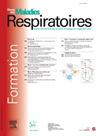Role of CRACR2A in the development of pulmonary arterial hypertension
IF 0.5
4区 医学
Q4 RESPIRATORY SYSTEM
引用次数: 0
Abstract
Introduction
Pulmonary arterial hypertension (PAH) is a rare, progressive, and devastating disease resulting from the obstruction of distal pulmonary arteries. The pathobiology of PAH is multifactorial, involving all the cell spectrum of pulmonary circulation, including pulmonary arterial (PA) smooth muscle cells (PASMCs), endothelial cells (PECs), and PA adventitial fibroblasts (PAAFs). These cellular dysfunctions are characterized by enhanced migration, proliferation and apoptosis resistance. Moreover, in PAH-hPASMCs, calcium signaling is exacerbated contributing to hPASMCs abnormalities. A mutation of CRACR2A, a regulatory partner of the calcium (Ca2+) channel Orai1 has been identified in an Italian PAH patients’ cohort suggesting its involvement in PAH development. Orai1, the main Ca2+ channel of the Store-Operated Ca2+ Entry (SOCE) is increased in expression and function in PAH-hPASMCs and participate to PAH pathogenesis. SOCE is triggered by STIM1, a calcium sensor of the endoplasmic reticulum (ER) that activates Orai1 after ER calcium depletion. CRACR2A is known to stabilize Orai1/STIM1 interaction.
Methods
We used a whole exome sequencing approach to identify CRACR2A variants. We used a siRNA strategy against CRACR2A in hPASMCs, hPECs, and hPAAF isolated from control and PAH patients. We then measured the consequences of the CRACR2A knockdown on SOCE by Ca2+ imaging measurement, on cell proliferation, migration and in vitro angiogenesis. Finally, we measured the consequence on SOCE and Orai1 protein expression in PAH-hPASMCs overexpressing CRACR2A.
Results
We identified additional variants of CRACR2A in PAH patients strengthening CRACR2A involvement in PAH development. Using immunofluorescence staining on human control and PAH lungs, we found that CRACR2A is expressed in control and PAH. By immunoblot, we showed that CRACR2A protein expression is unchanged in control and PAH-hPECs and hPAAFs, whereas its expression is reduced in PAH-hPASMCs. By the siRNA strategy, we found that SOCE, migration, and proliferation were decreased in control-hPASMCs transfected with siCRACR2A. Surprisingly, in PAH-hPASMCs, the knockdown of CRACR2A strongly increased SOCE and Orai1 expression. In contrast, CRACR2A overexpression in PAH-hPASMCs reduced SOCE. In PAH-hPAAFs, the knockdown of CRACR2A increases SOCE as in PAH-hPASMCs.
Conclusion
These results indicate that CRACR2A plays an essential role in pulmonary vascular cells from control and PAH patients by its involvement in SOCE, proliferation, and migration. The reduced CRACR2A expression in PAH-hPASMCs could partly explain increased Orai1 expression and function in PAH-hPASMCs. These results suggest that CRACR2A dysfunction is involved in PAH pathogenesis.
CRACR2A在肺动脉高压发生中的作用
肺动脉高压(PAH)是一种罕见的、进行性的、毁灭性的疾病,由远端肺动脉梗阻引起。PAH的病理生物学是多因素的,涉及肺循环的所有细胞谱,包括肺动脉(PA)平滑肌细胞(PASMCs)、内皮细胞(PECs)和肺动脉外基质成纤维细胞(PAAFs)。这些细胞功能障碍的特征是迁移、增殖和抗凋亡增强。此外,在PAH-hPASMCs中,钙信号加剧导致hPASMCs异常。在意大利PAH患者队列中发现了钙(Ca2+)通道Orai1的调控伙伴CRACR2A突变,提示其参与PAH的发展。存储操作Ca2+入口(SOCE)的主要Ca2+通道Orai1在PAH- hpasmcs中表达和功能增加,并参与PAH的发病。SOCE是由STIM1触发的,STIM1是内质网(ER)的钙传感器,在ER钙耗尽后激活Orai1。已知CRACR2A稳定Orai1/STIM1相互作用。方法采用全外显子组测序方法鉴定CRACR2A变异。我们在对照和PAH患者分离的hPASMCs、hPECs和hPAAF中使用siRNA策略对抗CRACR2A。然后,我们通过Ca2+成像测量测量了CRACR2A敲低对SOCE的影响,对细胞增殖、迁移和体外血管生成的影响。最后,我们测量了过表达CRACR2A的PAH-hPASMCs对SOCE和Orai1蛋白表达的影响。我们在PAH患者中发现了CRACR2A的其他变体,加强了CRACR2A在PAH发展中的作用。通过免疫荧光染色,我们发现CRACR2A在对照组和PAH肺中均有表达。通过免疫印迹,我们发现CRACR2A蛋白在对照组、PAH-hPECs和hPAAFs中表达不变,而在PAH-hPASMCs中表达降低。通过siRNA策略,我们发现转染siCRACR2A的对照hpasmcs的SOCE、迁移和增殖都降低了。令人惊讶的是,在PAH-hPASMCs中,CRACR2A的敲低显著增加了SOCE和Orai1的表达。相反,在PAH-hPASMCs中,CRACR2A过表达降低了SOCE。在PAH-hPAAFs中,CRACR2A的敲低增加了SOCE,与PAH-hPASMCs一样。结论CRACR2A参与肺血管细胞的SOCE、增殖和迁移,在对照组和PAH患者肺血管细胞中发挥重要作用。PAH-hPASMCs中CRACR2A表达的减少可以部分解释PAH-hPASMCs中Orai1表达和功能的增加。这些结果提示CRACR2A功能障碍参与了PAH的发病机制。
本文章由计算机程序翻译,如有差异,请以英文原文为准。
求助全文
约1分钟内获得全文
求助全文
来源期刊

Revue des maladies respiratoires
医学-呼吸系统
CiteScore
1.10
自引率
16.70%
发文量
168
审稿时长
4-8 weeks
期刊介绍:
La Revue des Maladies Respiratoires est l''organe officiel d''expression scientifique de la Société de Pneumologie de Langue Française (SPLF). Il s''agit d''un média professionnel francophone, à vocation internationale et accessible ici.
La Revue des Maladies Respiratoires est un outil de formation professionnelle post-universitaire pour l''ensemble de la communauté pneumologique francophone. Elle publie sur son site différentes variétés d''articles scientifiques concernant la Pneumologie :
- Editoriaux,
- Articles originaux,
- Revues générales,
- Articles de synthèses,
- Recommandations d''experts et textes de consensus,
- Séries thématiques,
- Cas cliniques,
- Articles « images et diagnostics »,
- Fiches techniques,
- Lettres à la rédaction.
 求助内容:
求助内容: 应助结果提醒方式:
应助结果提醒方式:


